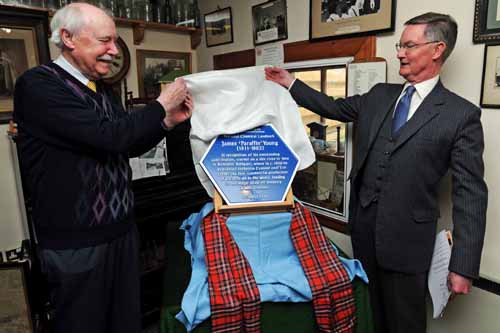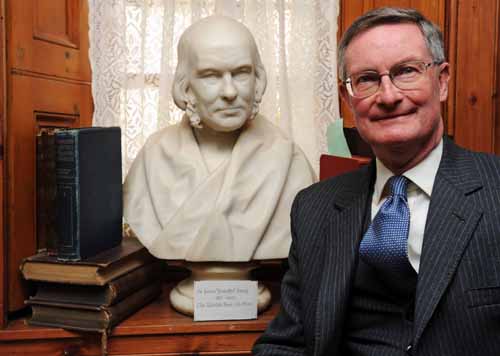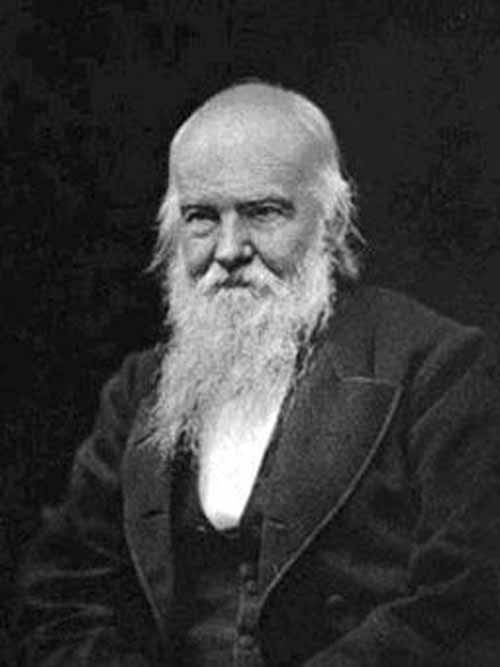THE GREAT-great-grandson of James “Paraffin” Young unveiled the Royal Society of Chemistry landmark blue plaque in his ancestor’s honour at the Bennie Museum, Bathgate today.
Ian Blackley, a descendant through Young’s daughter Annette, said he was delighted at the recognition of his ancestor’s achievements: “My family and I are very proud to be here in Bathgate today to see the unveiling of the RSC’s chemical landmark plaque in honour of my great-great-grandfather.
“I hope it serves as a reminder to the public and the scientists of the future, some of whom I hope are here today, of the important legacies that scientific breakthroughs have for many generations.”
Alex Smith, who worked in the mine, unveils the blue plaque with Ian Blackley
Mr Blackley said that among his Paraffin Young papers is a receipt from the Secretary of the Chemical Society of London, the precursor to the RSC, at Burlington House dated 4 October 1876 for a presentation copy of Graham’s Chemical and Physical Researches which Young and his close friend Robert Angus Smith compiled and had published.
“Many of the recipients of presentation copies, including Sir Joseph ‘Light Bulb’ Swan, sent kind manuscript letters of acknowledgement,” he added.
The RSC announced last year on the 200th anniversary of his birth in Drygate, Glasgow it was going to award a chemical landmark plaque in honour of Paraffin Young.
Young was not simply a scientist, but also a philanthropist, adventurer and anti-slavery campaigner.
Mr Blackley is descended from the scientist via Young’s daughter
He worked as an assistant to Thomas Graham at Anderson’s Institution in Glasgow, despite having a scant education. He left academia to concentrate on commercial ventures and successfully worked out a process for distilling naphtha, flammable liquid mixtures of hydrocarbons, into oil, which could be used for lighting and lubrication in Manchester’s cotton mills.
When the source dried up, he looked around for another source of raw materials. Word reached him that the people of Bathgate used ‘cannel coal’ (or candle coal as it burned like a candle) to light their houses. The news drew him to West Lothian – a decision which was to reap huge rewards.
The subsequent shale oil boom transformed the economy and the landscape of West Lothian, leaving huge piles of shale across central Scotland. At its height, there were 40,000 people employed at 120 refineries in the region and three million tons of shale and coal were mined and treated.
Professor Lesley Yellowlees, RSC President-Elect, said: “Sites that are awarded Chemical Landmark status have either played a major part in the development of chemical science or have seen a development of chemical science that has made a significant contribution to the health, wealth or quality of life of the nation – and Paraffin Young’s legacy fits exactly that.”
Young kick started the shale oil boom
Professor Yellowlees also said she was delighted that students from the James Young High School, Bathgate Academy and St Kentigern’s Academy were present. “I hope that not only will they take from the event the pride that Scotland has in a distinguished scientist of the past in James Young, but that they also are inspired by the exciting opportunities that exist in science today to pursue an intellectually challenging and rewarding career in the future,” she added.
Professor Michael Hitchman, an Honorary Senior Research Fellow at the University of Strathclyde’s department of pure and applied chemistry, was also present. He is a past holder of the Young Chair of Technical Chemistry, established through a gift by Paraffin Young.
The RSC chemical landmark plaque is inscribed to Paraffin Young: “In recognition of the outstanding contribution, made on a site close to here in Birniehill, Bathgate, where in c.1850 he processed torbanite (‘cannel coal’) to create the first commercial production of paraffin oil in the world, leading to the major shale oil industry in West Lothian.”
In 1873 Young was elected a Fellow of Royal Society and in 1879 he was awarded an honorary doctorate of St Andrews University. James Young died at his home, Kelly House, near Wemyss Bay, on 13 May 1883, and is buried at Inverkip cemetery.




